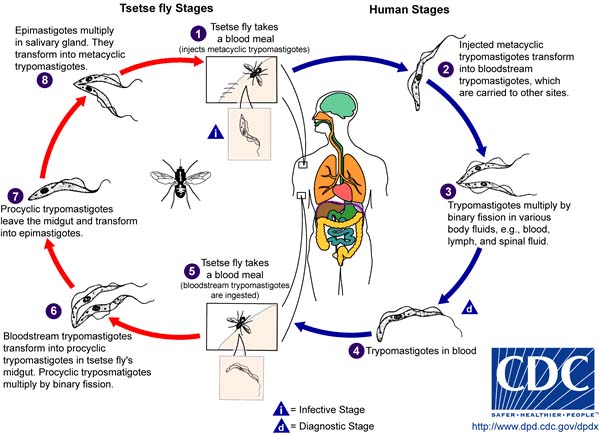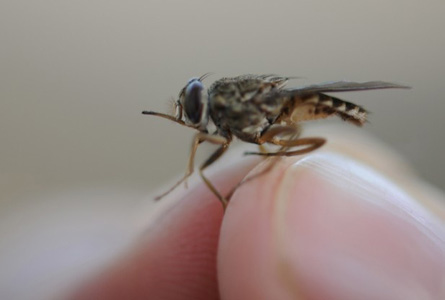Quick Facts
|
Human African Trypanosomiasis (HAT), also known as African Sleeping Sickness is a parasitic disease that is transmitted through the bite of an infected tsetse fly. The early stages of the disease can include flu-like symptoms and in some cases can include heart abnormalities. During the advance stages of the disease, the parasites enter the brain leading to encephalitis, coma and death. HAT is 100% fatal if left untreated. Most of the exposures to the tsetse fly and therefore the parasite occur in rural populations, which are poor and lack adequate health systems. Currently treatments rely on medications that are toxic, painful, expensive and are becoming ineffective due to parasite resistance. Thus, due to limited health care and poor treatment options, infection typically results in death. Development of effective, safe treatments is desperately needed for this devastating disease.
What is it?
Trypanososma brucei is a parasitic protozoan. When an infected tsetse bites an animal or human to take a blood meal, T. brucei parasites (trypomastigotes) in the fly's saliva enter first the lymphatic system and then the blood system. Parasites replicate in blood cells, eventually causing cell rupture to allow release of parasites back into the blood stream to infect new cells. Eventually parasites breach the blood-brain barrier and infect the brain, leading to irreversible neurological damage, coma and death.

Where does it occur?
 African Trypanosomes are endemic in 36 countries located in sub-Saharan Africa, putting approximately 60 million people at risk for this disease. The parasite can infect both humans and domesticated live stock (sheep, cattle, horses, cattle, dogs, pigs), thus impact both the health and economic development of these countries. It is estimated that up to 70,000 people are infected annually, and without early treatment the disease is usually fatal.
African Trypanosomes are endemic in 36 countries located in sub-Saharan Africa, putting approximately 60 million people at risk for this disease. The parasite can infect both humans and domesticated live stock (sheep, cattle, horses, cattle, dogs, pigs), thus impact both the health and economic development of these countries. It is estimated that up to 70,000 people are infected annually, and without early treatment the disease is usually fatal.

 The tsetse fly kills people and livestock in Africa. Credit: Abraham Mayoke at Kenya Agricultural & Livestock Research Organization (KALRO) and Biosciences eastern and central Africa - International Livestock Research Institute (BecA - ILRI) Hub.
The tsetse fly kills people and livestock in Africa. Credit: Abraham Mayoke at Kenya Agricultural & Livestock Research Organization (KALRO) and Biosciences eastern and central Africa - International Livestock Research Institute (BecA - ILRI) Hub.